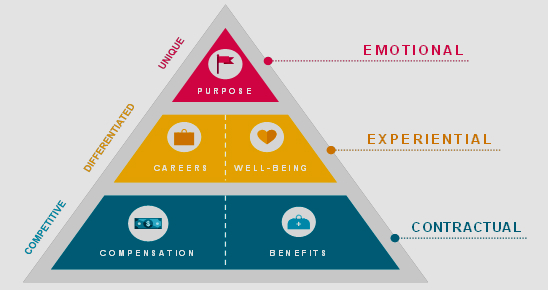Curating a compelling employee value proposition in emerging markets

Mercer recently published a research paper, “Thriving in an era of disruption,” and the subtext of this report’s title, “Putting people at the center of change,” is at the heart of this whitepaper. As companies look at various ways of creating economic value, thriving organizations realized that people have become more and not less important amidst the rapid transformation in human history. Although jobs disappeared when manufacturing processes were automated, design skills became more critical and new jobs emerged. The technologies of the fourth industrial revolution will continually need new skills, while digitalization will enable micro-economies to be built locally – driven by people’s imagination, not the economies of globalization.
Understanding the impact of these changes and preparing people to ride the crest of opportunity is paramount. And this preparation begins with the fostering of a culture where people can thrive in the workplace. As Louis Gerstner, the legendary CEO of IBM who turned around the tech behemoth back in the ’90s famously said, “Culture isn’t one aspect of the game, it is the game.”
The historical ‘deal’
In the 20th century, the loyalty contract defined the relationship between employer and employee. While the contract met the needs of pay, benefits and job security, employees offered a lifetime of work commitment. However, over the past 20 years, the engagement contract has been the dominant model. While organizations ensure their workforce is fully invested by meeting the basic criteria, they also seek to differentiate employee experience through career management and wellness programs.

Source: Mercer Thrive Research
The New ‘Deal’
Our new perspective of thinking about the new ‘deal’ to enable people to thrive, positions rewards into three primary categories of the employee value proposition continuum:
Contractual: Represents the traditional compensation and benefit deal
Experiential: Encompasses the way an employee experiences the organization both inside and outside work - from Careers to Wellbeing programs
Emotional: Represented by the connection created through a sense of purpose. This is driven by the employee’s connection to the vision or mission of the organization, as well as its social responsibility initiatives. This includes not only the meaningful impact created through the organization’s products and services but also the option to provide employees time and resources to engage in charitable initiatives that provide personal fulfillment.
There is a shift away from work-life to a new concept of wellbeing, which is a holistic notion that addresses the physical, emotional and financial health of employees.
In a recent HBR article, Facebook’s CHRO defined the deal at Facebook in terms of three buckets of motivators: career, community, and cause. When these three are fulfilled, people bring their whole selves to work and create significant economic value and impact.
Many companies are creating uniqueness in the area of purpose. Our engagement research showed that this element can help create “stickiness” with an employer and have more retentive strength than traditional rewards. This is especially relevant for SMEs as they compete for talent with larger companies and may not have the means to differentiate on pay alone.
Businesses and HR functions have thus far relied on anecdotal evidence, market trends and generalizations around employee segments to try and understand what people seek. Translating the Employee Value Proposition (EVP) or the deal into a compelling experience for each and every employee, however, requires both art and science. The ‘science’ starts with workforce analytics to map internal labor movements and identify ‘personas’ that represent micro-populations of employees with a unique combination of needs. The ‘art’ of the EVP describes the human contact – how managers and co-workers shape the work environment with meaningful personal interactions.
Mercer’s Thrive research can be found here














